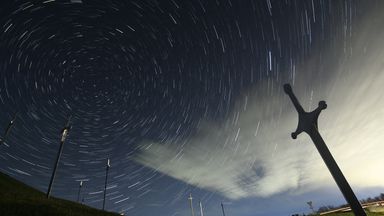The solar eclipse may be over, but skywatchers have another reason to keep looking up: the Pink Moon.
The full moon of April, called the Pink Moon, will be visible from Monday to Wednesday (April 22 to 24). It will reach the crest of its full phase at 7:49 p.m. Eastern Time on April 23. The full moon will also coincide with the Lyric Meteor Shower, which will peak around April 22.
What Is the Pink Moon?
The Pink Moon is named after the color of blooming Spring flowers. Other names for the moon include the Breaking Ice Moon, Budding Moon, Awakening Moon and Egg Moon.
There are also many Native American names for April's full moon, including the Moon of the Red Grass Appearing (Oglala), Sprouting Grass Moon (Tlingit), Moon of Blackberry (Choctaw), Flower Moon (Cherokee) and Moon of the Big Leaves (Apache), according to Farmers' Almanac.
In Judaism, the Pink Moon is known as the Passover Moon because it marks the first day of the Jewish festival of Passover. Another name for April's full moon is the Paschal Moon because it occurs around Easter.
Is the Pink Moon Actually Pink?
Although it is called the Pink Moon, this month's full moon will look like any other—so it will not actually be particularly pink in color.
During dusk, however, the Pink Moon may well appear orange. This is because you are viewing it through the densest part of the Earth's atmosphere, which is filled with particles that absorb and scatter light.
These atmospheric particles tend to scatter shorter wavelengths of light more than longer wavelengths. Orange and red light—which have longer wavelengths—tend to pass through the atmosphere, while shorter wavelengths of light such as blue get scattered.
What Is a Full Moon?
The phases of the Moon are caused by the relative positions of the moon, sun and the Earth. When we look up at the moon, we don't always see the same amount of its surface being lit up—and this change in the shape of the Moon is called its phase.
If the moon is on the other side of the Earth compared to the sun, then the near side of the moon will be fully lit up, which is a full moon.
How To Spot the Pink Moon
The best time to see the Pink Moon will be at moonrise where you are located on April 23. In New York, sunset is at 7:43 p.m. EDT, and moonrise is at 7:44 p.m. EDT. In London, sunset is at 8:10 p.m. BST, and moonrise is at 7:59 p.m. BST. Binoculars will give you a spectacular close-up of the moon.
When Is the Lyrid Meteor Shower?
The Pink Moon is set to coincide with the peak of the Lyrid meteor shower on April 22, according to the American Meteor Society. Although the peak is narrow, skywatchers in a location where the skies are dark and clear may still spot the odd meteor.
Do you have a tip on a science story that Newsweek should be covering? Do you have a question about space? Let us know via science@newsweek.com.
Disclaimer: The copyright of this article belongs to the original author. Reposting this article is solely for the purpose of information dissemination and does not constitute any investment advice. If there is any infringement, please contact us immediately. We will make corrections or deletions as necessary. Thank you.



